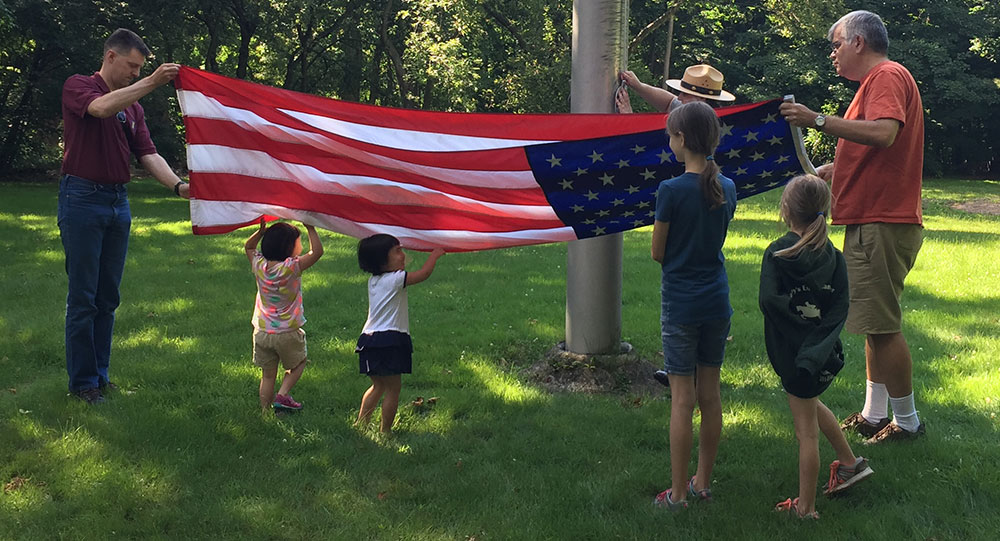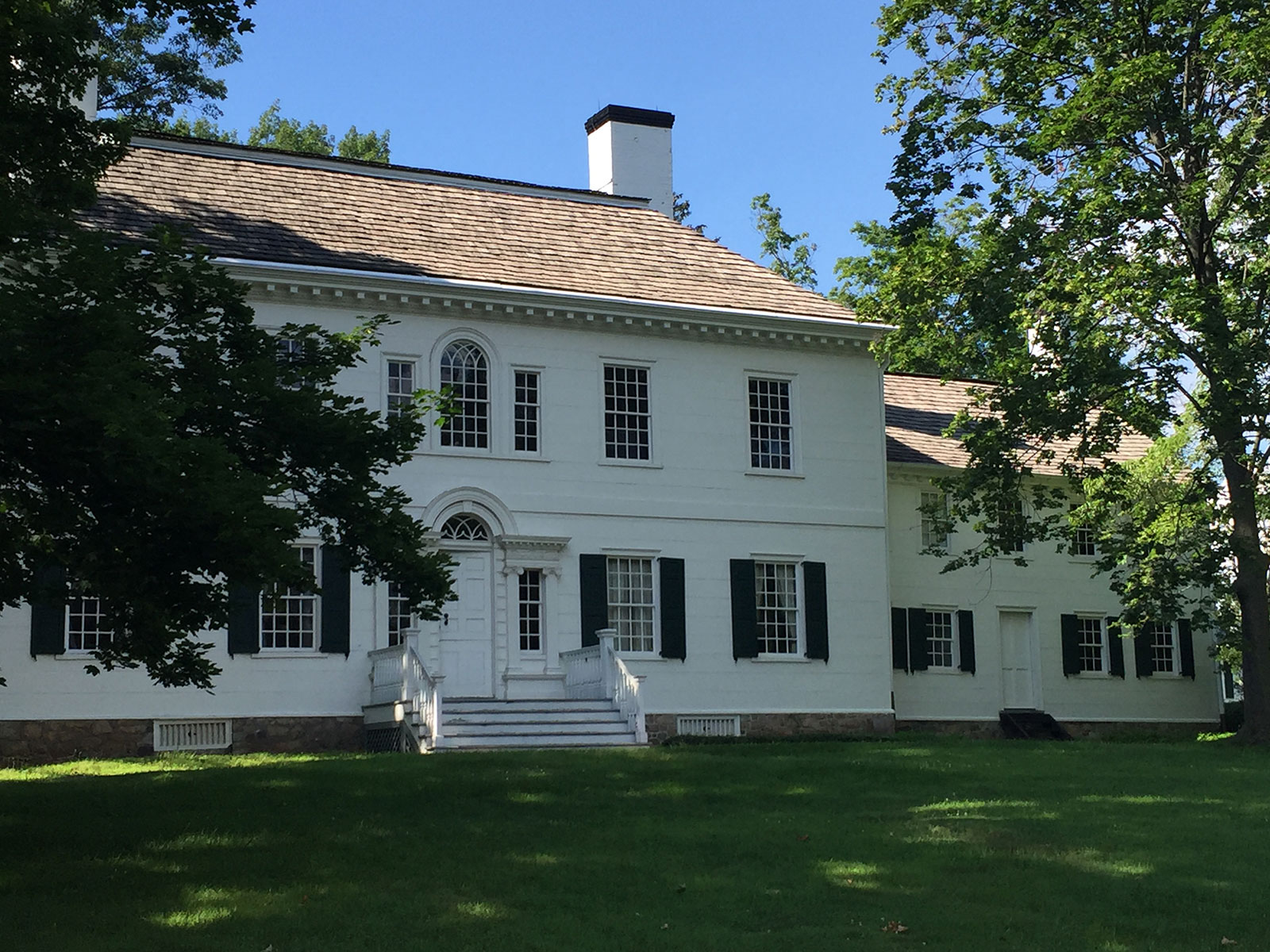The Ford Mansion was erected between 1772 and 1774 by Colonel Jacob Ford, Jr. At the time of its construction, it was located on a 200-acre tract and was situated about half a mile from the center of Morristown which then contained 250 people. During the winter of 1779-1780, General George Washington, accompanied by Mrs. Washington, occupied the home as his official headquarters while his troops were bivouacked in Jockey Hollow. In 1872, the house was sold by Ford heirs to the Washington Association of New Jersey which formed to operate it as a historic museum until the establishment of the Morristown National Historical Park in 1933.
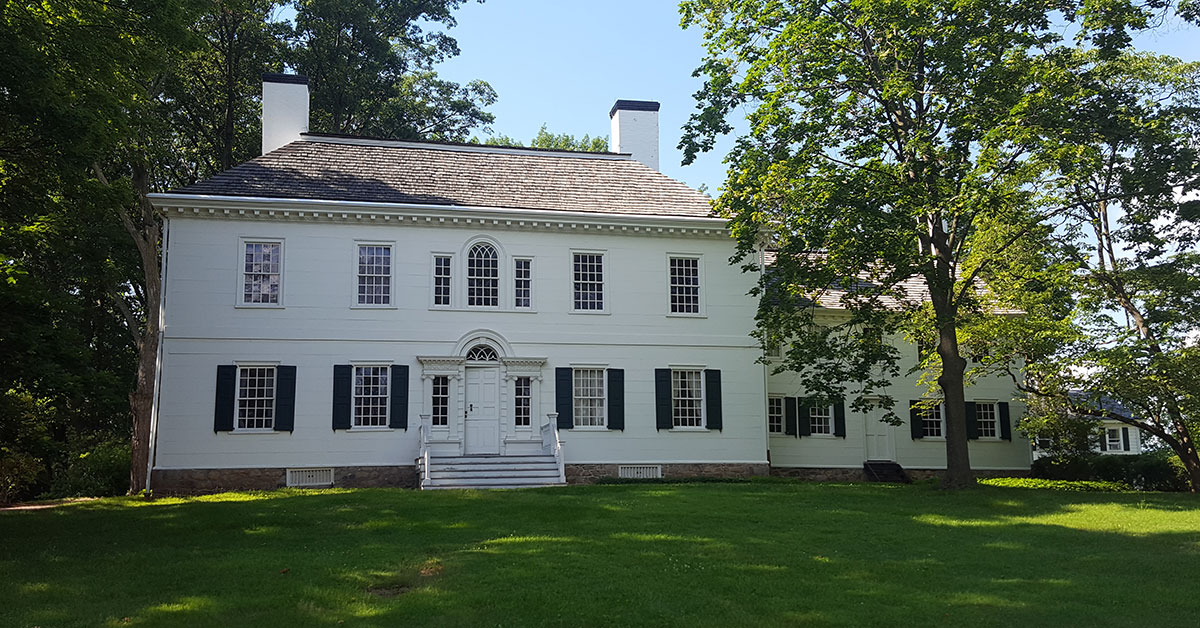
Today the Ford Mansion and the grounds surrounding it cover a site in a residential area of Morristown bounded on three sides by city streets. Interstate 287, a limited access highway, runs immediately west of the Ford tract passing under the east and west bound lanes of Morris Avenue. Private residences, all built at least 37 years ago, are located across city streets from the Ford tract. An elementary school is situated just west of the interstate. The unit is landscaped with turf separated by hedges and shaded by specimen deciduous and evergreen trees. This landscaping was done ca. 1900 and during the 1930's.
Archeological investigations in the vicinity of the mansion, done between 1936 and 1939, discovered a stone fence that had extended southwesterly from that corner of the mansion to Morris Avenue, the 10' x 25' foundation of an outbuilding behind the mansion, a 10' x 14' foundation of a shed or lean-to adjacent to the kitchen wing, and two cisterns.
The house was restored in 1938-1941 by the National Park Service after extensive architectural, archeological, and historical research were conducted.
The Ford Mansion is a large two-story detached house, built in the late Georgian style. The structure is wood frame resting on stone foundation walls. It consists of a large rectangular main section with central hall and four rooms on each of the floors, and a rectangular, two story (five bays on the front) kitchen wing on the east side. There is also a large unfinished attic and a basement. The wood shingle roof is a broad, hipped gambrel, and there are two chimneys in the main section and one in the kitchen wing.
The most important part of the architectural design of the house is its symmetrical, five-bay front facade. The focus of this facade is a handsomely proportioned central doorway with side lights and a fanlight of carved wood in the Palladian motif. This is repeated in the Palladian window above. The wide clapboards of the walls are flush boarded horizontally on the front facade to simulate a surface of dressed stone.
The cornice is elaborate, accented by pronounced dentilation. The sides (two-bay) of the house are covered with clapboards. Windows in the main section are 12/12 double-hung sash with the exception of the Palladian style doorway and window in the center bay on the first and second stories respectively. Windows in the kitchen wing are 6/6. A small door, reached by three steps, is in the second bay (close to the main section) and gives access to the first floor of the kitchen wing.
There are exterior shutters on the lower windows with the exception of the Palladian-style features in the central bays.
A study conducted while rehabilitation work was carried out on the Ford Mansion in the early 1960's cast some doubt on earlier phases of exterior restoration (1938-41). The diaries of Gabriel Ford (1796-1860's) refer, for instance, to the existence of dormer windows in parts of the original structure. These were removed in 1938 by the National Park Service. The diaries also refer to the existence of a wooden stoop and railing in the original structure whereas the structure then was approached by a flight of five brownstone steps. As far as can be determined from the Ford diaries, no major changes were made in the house while it remained a residence of the Fords. When the Washington Association of New Jersey acquired the property, some changes were made in the rooms, but details are very general in their reports.
The Ford Mansion is furnished with a number of fine Ford family pieces that are said to have been in the house when General Washington used it as his headquarters. Other pieces are of the period of 1780 or earlier.
Genius Value
Not only did George Washington "sleep here," but he lived and worked here for months. General Washington and the Continental army encamped here from December 1779 to June 1780, where they survived through what would be the coldest winter on record. While much of the area is radically changed, the feeling of the time is inescapable.
Arrival
The park is minutes off of Rt 287. We arrived from the south, so upon exiting, we were on a one-way street that passes immediately in front of the Ford Mansion. There is no entrance on that side, though, so we had to drive a bit further down the road, then basically go around the block. There are several signs pointing the way, but the actual entrance to the park is on the left and in a curve, so you have to be on the lookout for it. Upon parking you are at the rear of the Washington's Headquarters Museum, where you pay your entrance fee and get your tickets.
Parking
There is a lower and upper parking lot, that are more than ample. We parked in the lower parking lot. If you try for the closer upper parking lot and it happens to be full, you'll have to go round and round again to get back to the lower lot, but I don't think it fills very often. It's a short walk even from the lower parking lot, though. Parking is free.
Ticketing
Upon entering the museum, there is a little ticket window. Entrance pays for the museum and the Ford Mansion, which is a short walk away. Upon paying (or not, because we had a fourth grader with us!), we received tickets for the next guided tour of the Ford Mansion, which happen on the hour. I believe the tours are limited to 20 people, so they could fill up. Reservations are available for group tours. You can spend your time waiting for the next tour by seeing the orientation video and the galleries in the museum. The museum also has a bathroom, while the Ford Mansion does not.
The Mansion
The Ford Mansion does not seem to be wheelchair or stroller accessible. There are a few steps leading into the building and it contains steep, narrow staircases. The building contains a wide center hallway on both floors, so it's comfortable - roomey and air conditioned - but there is lots of "don't touch," so it's not great for small children. Infants in a carrier should be no problem.
The first floor consists of a wide central hallway with two rooms on either side. The first room on the left is the "War Department," where General Washington and his staff designed strategy in hopes to end the war with a victory.
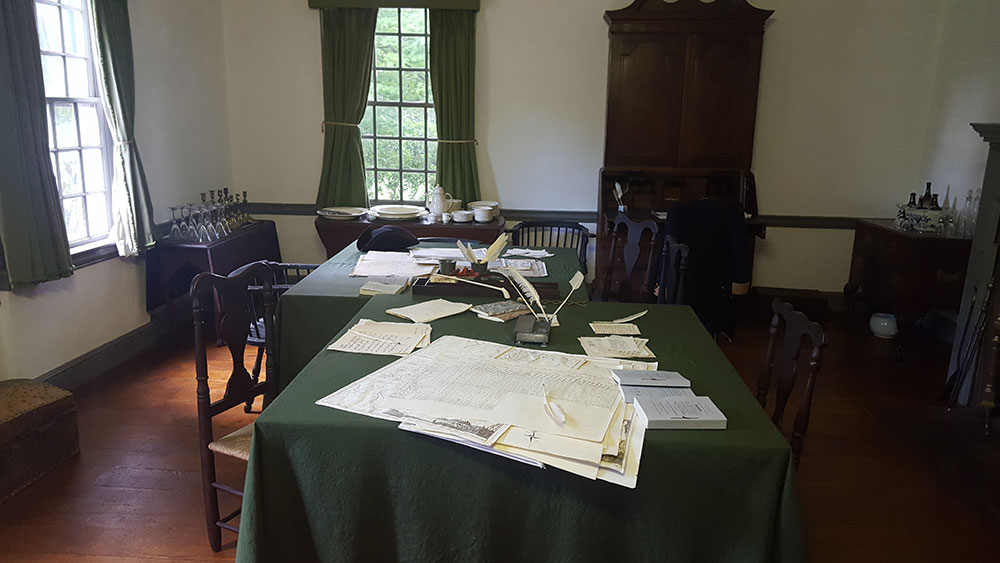
On the left side of the house, in the rear behind a staircase, is tucked George Washington's office. Privacy was not common in the 18th century, however General Washington was able to use this office to conduct wartime business.
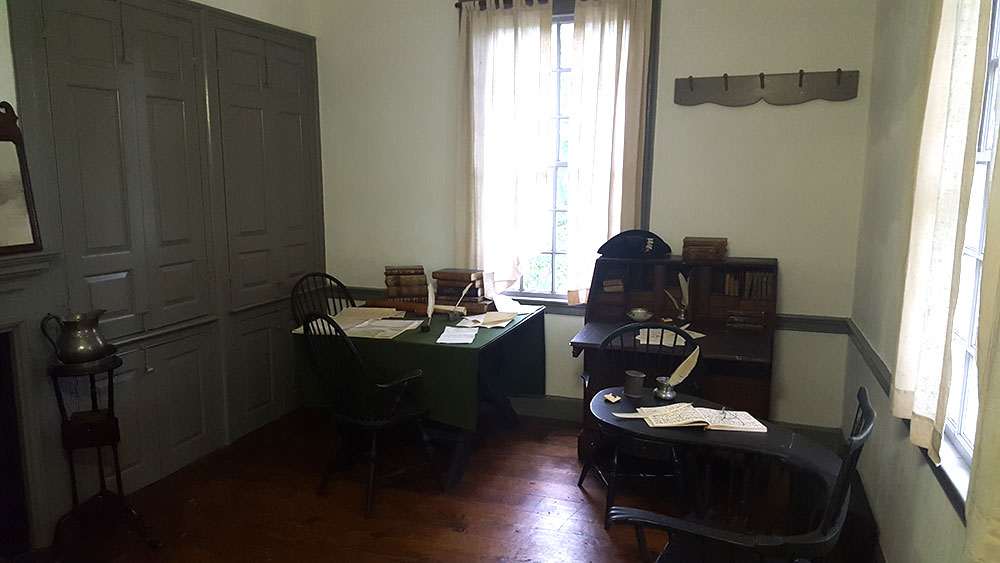
In the rear of the house on the right side is a bedroom that leads to the kitchen wing.

The second floor contains a bedroom thought to be used by George and Martha Washington.

Across from this bedroom is the bedroom for Washington's Aides de Camp. General Washington’s Aides used this room for sleep and as office space for writing reports.

Similar to the first floor, there is a bedroom on the second floor that leads to the kitchen wing and the servant's quarters.
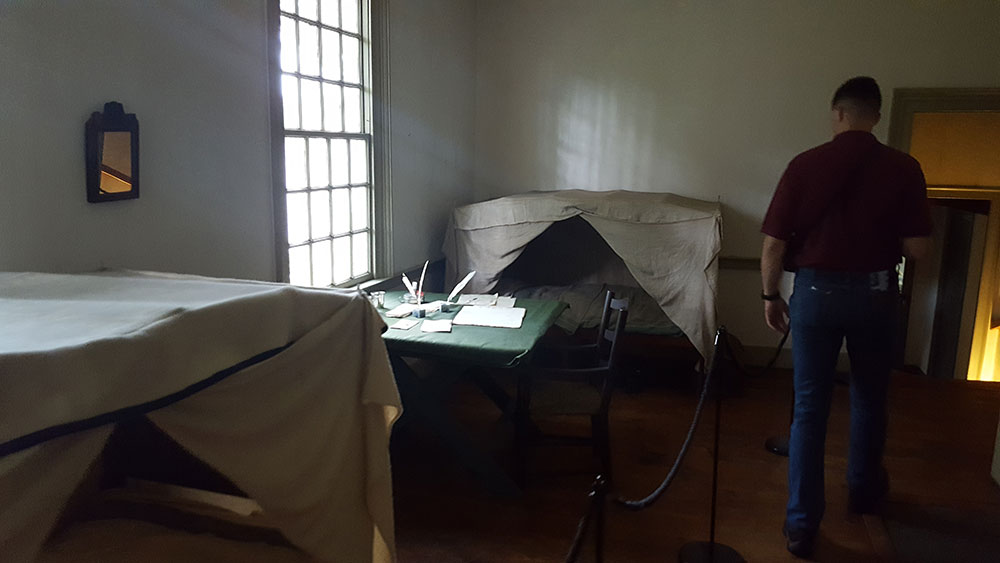
The second floor of the kitchen wing contains the servants' quarters. After a long hard day of tending to chores, servants would spread out these mattresses across the floor for sleeping. This area of the house was notable for having a much lower ceiling and rougher construction.

The second floor of the kitchen wing also contained another bedroom.
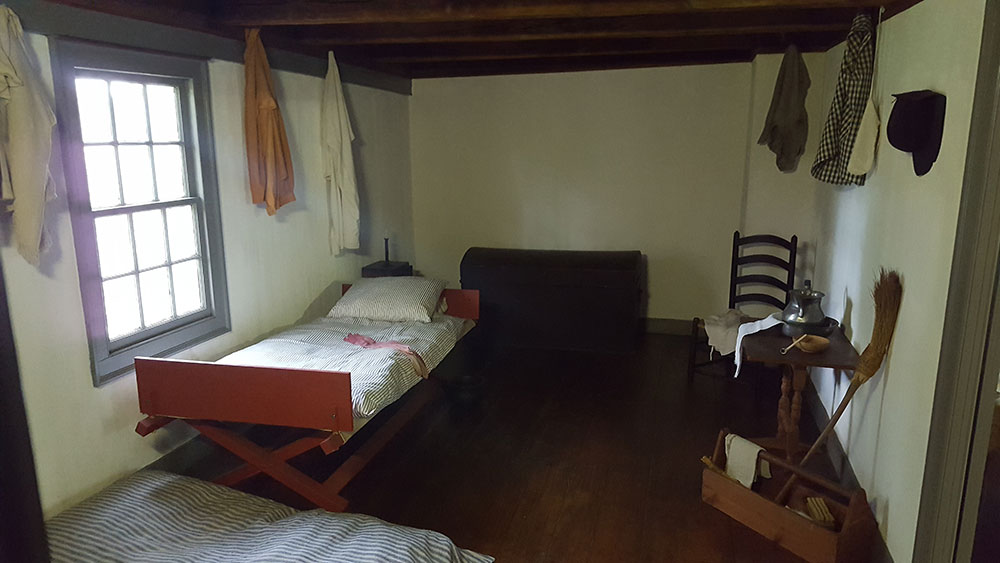
Back on the first floor of the kitchen wing, we saw a small pantry where the Ford family stored their food.

Next to the pantry, we found the kitchen. Kitchens were one of the busiest rooms in the home not just for cooking of meals, but also washing of laundry.

Finally, on the first floor, we come to the multi-purpose room. During the winter of 1779, Mrs. Ford not only used this room as her dining room but also as a bedroom and parlor.
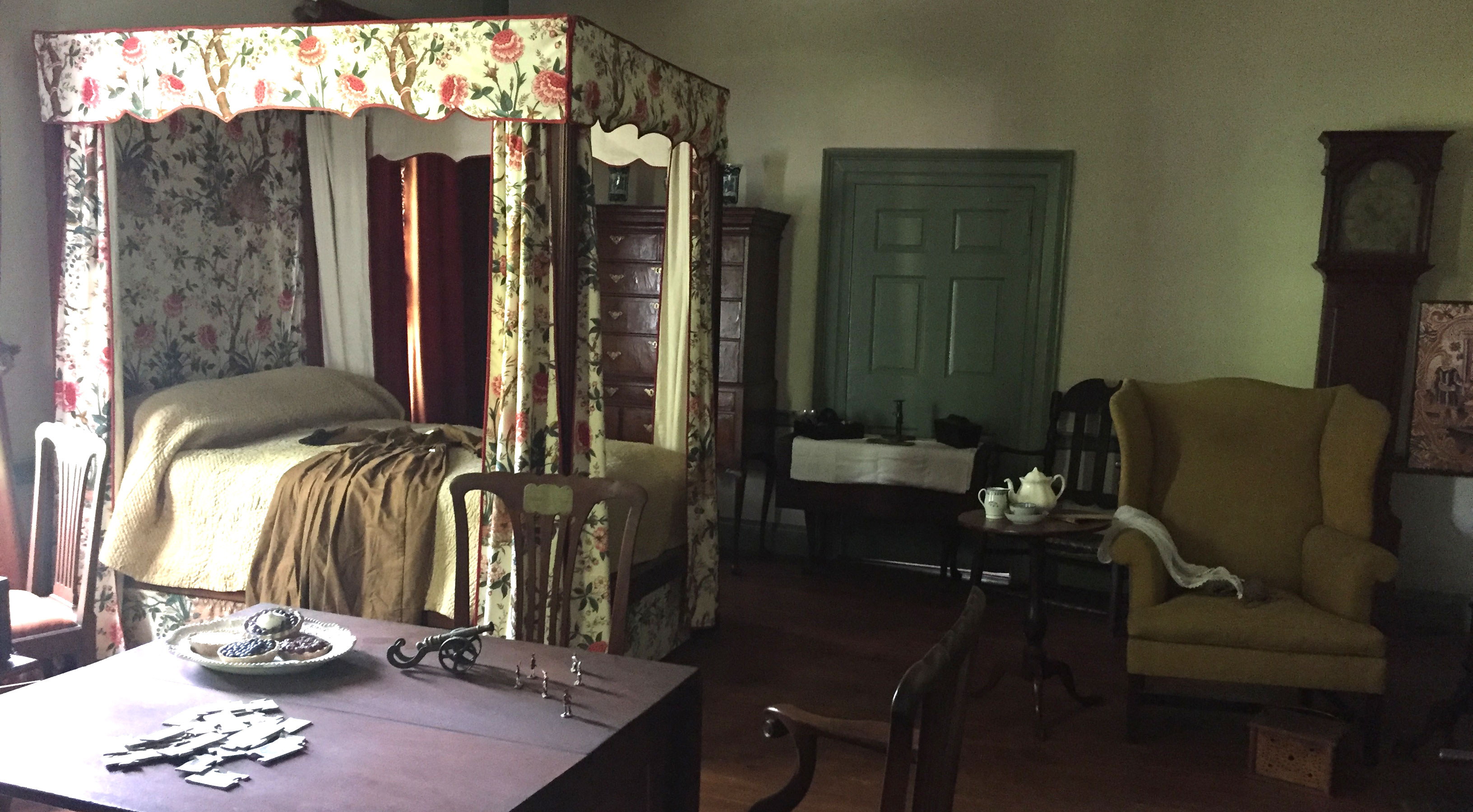
Conclusion
Overall, the Ford Mansion is nicely done and interesting. The visit was comfortable, as we did not have small children with us. A stroller would be fine on the first floor, but wouldn't be possible on the second floor or the kitchen wing. I'm sure a stroller could be safely left in the main hallway during the visit.
So much of the value of an historic house tour rests on the guide. Our guide was kind of grumpy and didn't really encourage interaction. She was knowledgeable and was able to answer the few questions that were posed.
As we were the last tour, the ranger asked for help in lowering the flag for the day. We were more than happy to oblige.
We have seen better historic home tours, but the profound history of the Ford Mansion certainly adds an extra kick.
Near Here
Morristown is a very vibrant town, with a rich history and many opportunities. There are numerous places to eat in the area as well as indoor and outdoor recreation areas.
- Lewis Morris County Park
- Patriot's Path
- Fosterfields Living Historical Farm
- Frelinghuysen Arboretum
- Historic Speedwell
- Acorn Hall, Morris County Historical Society
- Macculloch Hall Historical Museum
Related / Alternative Activities
- Washington's Headquarters Museum
- Crossroads of the American Revolution National Heritage Area
- Monmouth Battlefield State Park
- Washington Crossing State Park
- Fort Lee Historic Park
- Old Barracks Museum
Other Resources
